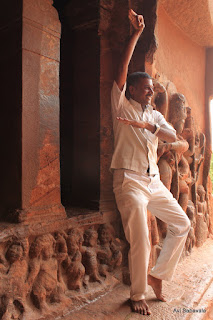This quaint little town has a small railway station! It was the capital of the early Chalukya dynasty (A.D. 540-756) and is famous for its cave temples hewn out of sandstone on the precipice of a hill. The name badami means almond colour which is the colour of the rocks in the area. The first 2 caves are Shiva temples, the third is a Vishnu Temple while the fourth is a Jain Temple. Some exquisite and intricate carving is to be found here
 |
| View of the Bhoothnath Temple from Cave 2 |
 |
| entrance to the cave |
 |
| Jambulinga Temple dates back to 699 A.D. |
 |
| Our guide gives us a Natraja pose |
 |
| A fort on top of the hill built by Tipu sultan |
Bhoothnath temple reached after a short walk from the caves is a scenic spot situated beside a small pnnd
A small but well curated museum near the Bhoothnath temple contains interesting relics of the Chalukya dynasty and is a good orientation to the structural and material heritage of the region.
Mahakuteshwar - a scenic 12 km drive brings one to the a temple neatly tucked away amidst rolling hills. It is time for the daily Arti (a Hindu devotional song sung in temples around 7 pm.). This is a Shiva temple which has a pond created by a natural spring. there are nearly 15 small shrines in the courtyard. The serene and peaceful atmosphere coupled with some beautiful medieval architecture made this visit really memorable.
Above and below - one of the many small temples/shrines in the area
Banashankari temple is dedicated to the Godess of the same name. this is one of the most ancient temples of Karnataka. A long winded line of devotees brought us to the inner sanctum sanctorium for getting darshan (viewing) of the Goddess.
The photos below are of the exterior as no photography is permitted inside
 |
| a large chariot greets you as you alight at the parking lot |
Pls click on the older posts tab to go to page 2 of this blog































No comments:
Post a Comment